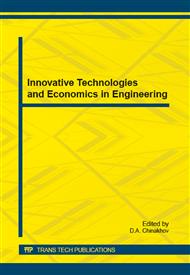p.188
p.192
p.196
p.202
p.206
p.210
p.216
p.224
p.231
The Technology of Production and Treatment of Materials in the Electric Field
Abstract:
The technical result of the method of production and treatment of materials in the weak constant electric current suggested in the given paper is the opportunity of regulating the physical and technical properties of materials. Treatment of materials in the electric field is a convenient and economically efficient method for producing a pure solid substance. The unit for producing and treating the materials in the weak non-contact electric field includes the experimental cell placed between two electrodes connected to the power supply through a voltage divider which is a number of elements connected by resistance in series which allows varying the voltage of the electric field in the experimental cell. The experiments demonstrated that the given technology allows growing mono-, micro-and whisker crystals of a number of inorganic salts (azides, halogenides of silver and alkali metals) having the prescribed size, reproducible physical and technical characteristics, regulated defect structure, long storage life (at least 6 months).
Info:
Periodical:
Pages:
206-209
Citation:
Online since:
October 2014
Authors:
Price:
Сopyright:
© 2014 Trans Tech Publications Ltd. All Rights Reserved
Share:
Citation:


